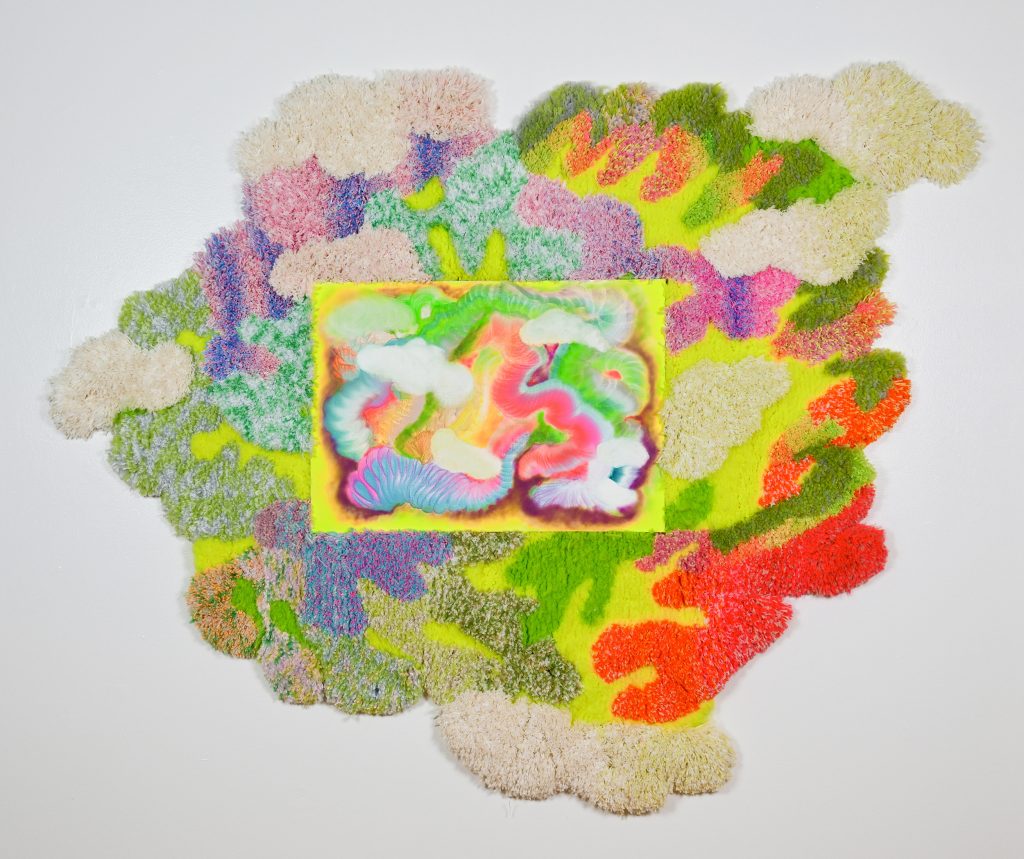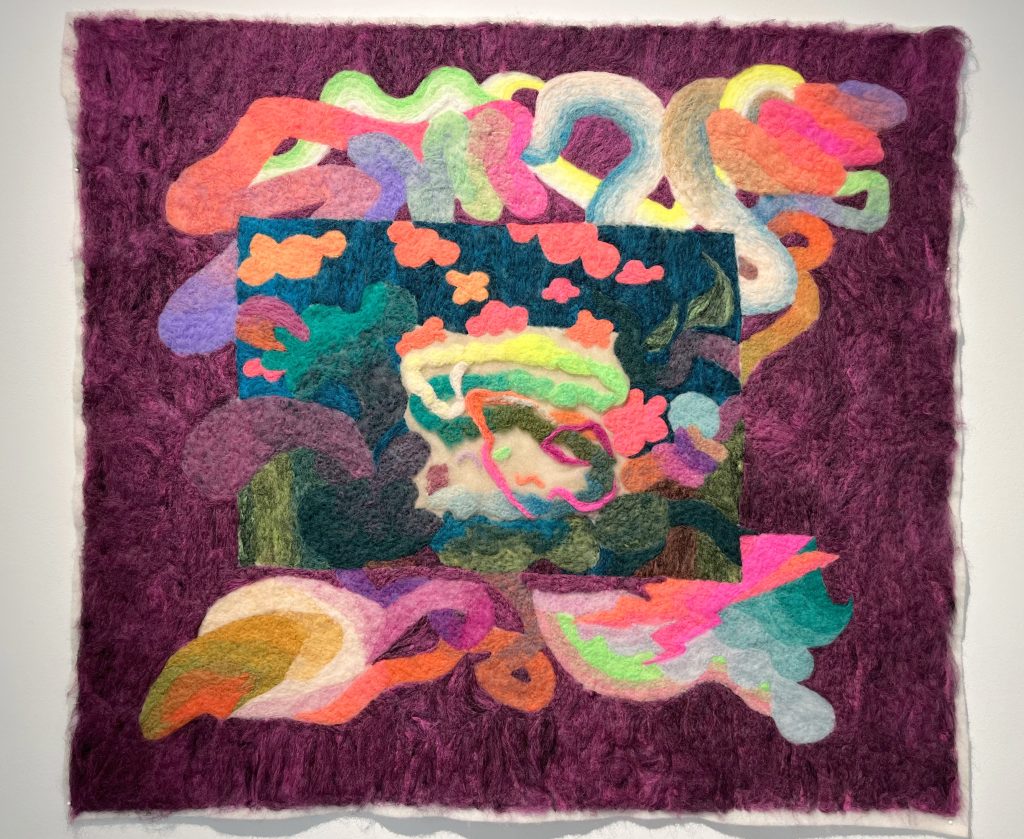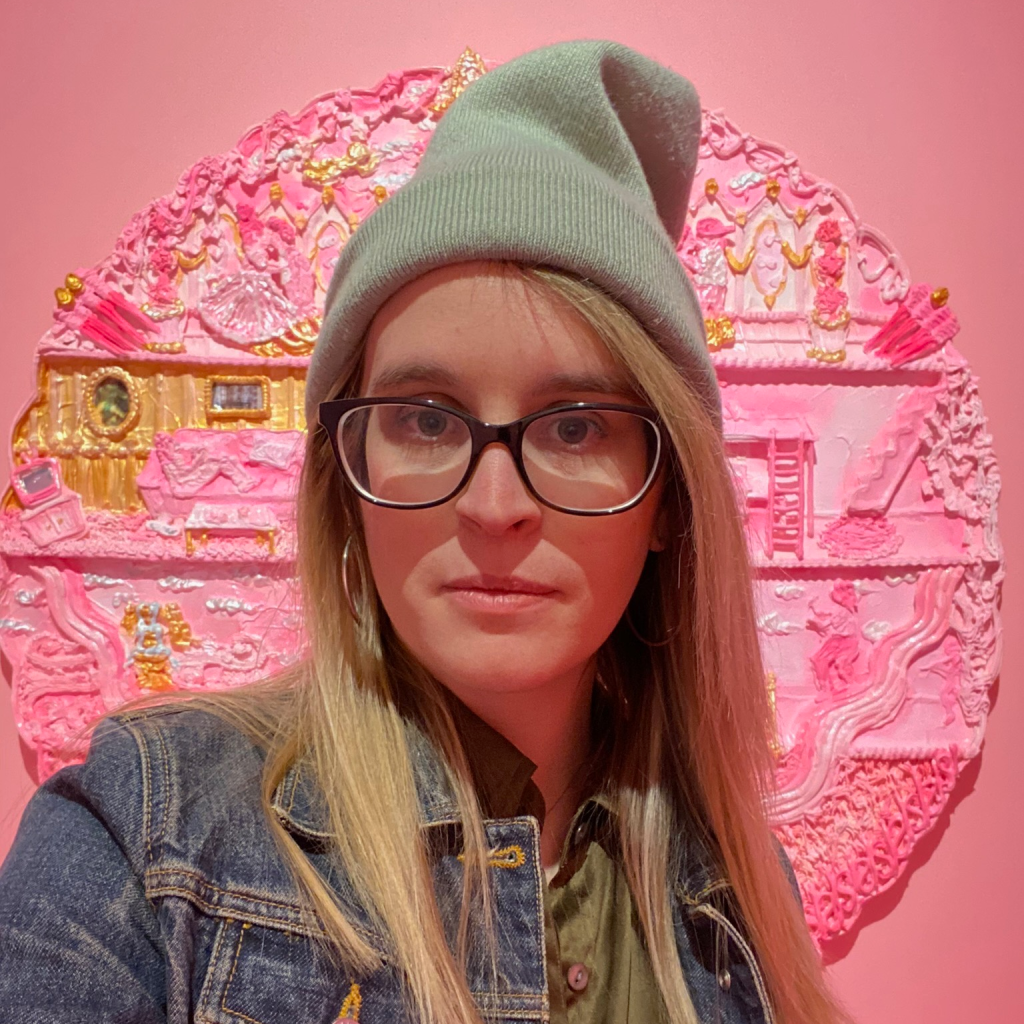Rachel Collier’s solo exhibition harnesses power from “the visual language of maps, topography, insets, picture-in-picture, scale and materiality, and radiant color to stir the spirit in preparation for advancement or departure.” Still Together at the Saint Kate Arts Hotel affords the viewer a chance to take shelter in colorful textiles and paintings representing a series of emotional landscapes from which to enter and depart. The exhibition evokes feelings through color, texture, and title that Collier associates with certain sentiments. It may not be possible to know exactly which emotions are being transmitted through the work, but close, prolonged inspection of each piece allows us to connect with colors, shapes, and textures that elicit familiar emotions, such as excitement, longing, and nostalgia.
Collier has built a body of work around materials that create an emotional map where we might encounter the artist’s personal memories and relate her experiences to our own. In the small gallery, between rotating exhibitions and the hotel’s artist in residence, we are invited to consider a series about the topography of memory. Engaging with Collier’s work means the same emotion might flicker in every viewer with a sensitive eye, but that brief connection to the feeling is certainly situated in memory at different times, places, and circumstances. Collier’s technical choices include creating shapes and lines that abruptly end and use negative space to squeeze the forms into a composition they are keen to resist. Irregular shifts in mark size and color support a kind of self-doubt, the kind that accompanies an uncertain memory. It is as if we are not being pressed to remember our lives accurately, but in patches that fade and change over time.
Since I was a visual artist before switching my focus to writing, several pieces conjured up playful studio memories. Water on Rocks brought back to mind material exploration and making freely drawn marks that later become a key focus within a piece. I saw sidewalk chalk and wet drapery, evoking innocent memories and visceral reactions to an unpleasant texture against my skin. At different moments during my first viewing, I felt tree sap, cold water, and indistinct shame. 2 Small Untitled Canvas Studies employ more solid brushstrokes and bold lines, but we are still invited to think of them as studies, perhaps functioning as a template for larger works to come, or even as fragments of Collier’s thesis on the slippery nature of recollection. In these studies, I encountered glowing lights in the dark, a time-based capture of neon movement. Describing how and why I associated my personal life with abstractions is as difficult as predicting how you might react. This is one enduring beauty of nonrepresentational art. We experience a timeless blend of raw emotions expressed through mediums tied to the individual and her sense of self as if we are looking at a map of another person’s inner world. Where one may feel pushed away from the granny smith greens and blurred and wormy airbrush strokes (Water on Rocks), another may recall summer carnivals in the curling marks, or a first warm night on the town, when lights crisscross over the road in the dark (2 Small Untitled Canvas Studies).

Collier’s paintings are only part of the exhibition, and her textile work gives the show a prevailing sense that the artist has manipulated fibrous materials so that the work extends beyond the frame to which a painting is naturally bound. The fabric is loosened and shorn, spreading and falling in organic shags that are not defined by boundaries, just the same way memories behave. Fibers are at the mercy of their environment—a breath of air, a change in the humidity—more so than the painted works. In a way, Collier’s textile compositions better capture the nature of remembering. But some memories are bound up permanently, even as the surrounding details are manipulated by time. Big Sky, positioned at the entrance, reconciles painting and fiber and solidity and malleability into one dynamic display. Big Sky pulsates outward, a wooly amoeba made of neon greens and candy purples, nothing at all like a natural sky. A painting is embedded into the textile, and the conflicting textures cause a visual intervention in the center of the tufts. To remember a specific moment caught in the haze of context is something nearly all of us experience. A static moment is captured by a cloud of emotion, trapped inside a version of the self in the past, morphing and budding and boundless and impossible.
A frequent absence of symmetrical borders allows Collier to push her interpretation of the fluctuating behavior our memories undergo. For example, the 38”x41” Untitled Felt Piece (given the title Kids in the Wood on Collier’s website) applies three layers of perspective depth created by felted wool. The most distant layer is a loosely tufted magenta wool that serves to contain the snaking shapes in the middle ground, as if to represent weather or abstractly set the emotional terms of this particular memory. In the center, a vibrant scene is nested in the foreground, this one with shapes and colors that begin to suggest clouds, trees, a river. If this is a reflection of Collier’s true intention—to give inexplicable emotions form and color—the titular suggestion of children in a natural scene is easily accepted, especially if one is able to encounter the work as if diving backwards into memory that has since become embedded in the monotone colors time imposes. An afternoon under the trees, muddy feet on the bank of a creek, staying out until the sky turns purple.

To the right of Kids in the Wood/Untitled Felt Piece is Wet Measure, made of paint on canvas, detailing two rectangles clearly defined against a background of the same types of marks. The colors allude to a desert landscape in cacti greens and sandy oranges, powdery floral pinks. The painting feels like an exercise in mark making, with rolling daubs and bloated lines that shift beneath more of Collier’s unique concept of clouds. It is instantly clear why Collier has chosen this approach: by suggesting the contours and colors of a place, a time, an emotion, the artist shows the viewer a path preset by our own individual experiences, and the audience can take it from there. It is possible, at the end of the gallery tour, to arrive at Wet Measure ready and primed to connect nonrepresentational forms to our private inner world.
Standing before Wet Measure, I felt an expanding warmth, as if standing in the direct sun, on the edge between solitude in arid nature and an optional return to community somewhere beyond the border. These feelings make describing the work difficult without drawing upon specific personal memories. When viewing Wet Measure, the intention is, as the artist statement encourages, to let the invisible medium of your own memories serve as the continuous thread through the work. Still Together, as an exhibition, celebrates similarities in reminiscence between complex, ever-changing individuals.
Still Together was on view at Saint Kate Arts Hotel in Milwaukee, WI from September 2, 2022 through January 22, 2023.

About the author: Annie Raab earned her BFA from the Kansas City Art Institute and her MFA from Virginia Tech. She has published fiction, creative nonfiction, art criticism, book reviews, interviews, and other forms since 2009. Her work has appeared in online and print publications, including Cream City Review, The Southampton Review, New Reader Magazine, Sculpture International, The Chicago Review of Books, Chicago Artist Writers, and more. She lives in the Midwest and partially on a sailboat.



